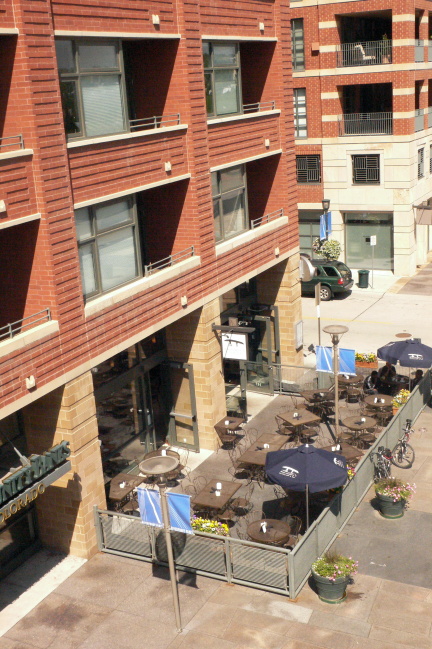Last week I described what I consider to be a fourth urbanism different from the New Urbanism, Everyday Urbanism, and Post (or Spectacle) Urbanism described by University of Michigan professor of architecture Douglas Kelbaugh.
My fourth urbanism has (at least) these characteristics: (i) it takes place in existing cities, by remaking and intensifying uses on existing urban landscapes; (ii) it incorporates existing or creates new city streets (sometimes on a grid, but always with a city-like "grain"), and then uses those streets to build frontages on; (iii) it is based on the most basic economics of cities, where the added wealth from concentrating economic activity allows for expensive features on building sites, such as underground parking; (iv) it depends on governmental action, both public investment and public planning, as much as actions by developers; (v) it is "green" because of its urban efficiency, not because of any special technologies; and (vi) it is characterized by contemporary architecture, but only if the architecture relates to or is subordinated to the complexity of the context of the city.
The name I've been thinking of to call this urbanism is Cityism because, most simply, it's all about cities.
I wrote about three places where I have seen Cityism occurring -- Vancouver, Barcelona, and my own city of Santa Monica --but there are many other cities where Cityism is taking place. I saw new projects that fit its description, for instance, in Denver, on old industrial lands along the Platte River, when I was there last month for the Congress of New Urbanism.

New development in Denver
So how does Cityism relate to the three urbanisms of Professor Kelbaugh?
Cityism borrows from (or perhaps a better way to put it is "shares with") all of Professor Kelbaugh's three other urbanisms. With New Urbanism, it shares a lot. One comment I received to last week's article was that what I described was completely consistent with the Charter of the New Urbanism. I won't argue. Cityism certainly shares the goals of New Urbanism when it comes to the street and how to use it.
And there are New Urbanists whose work is consistent with Cityism. In Denver I attended a talk by San Francisco architect Daniel Solomon, one of the founders of New Urbanism, who showed pictures of his recent work. Mr. Solomon is a New Urbanist (along with the other founders, for what it's worth) who is not categorically opposed to modern or contemporary architecture provided that it works in the context, and his work in the Bay Area is both urban and contemporary. If Cityists ever give awards, he will surely get one.
The same goals, however, do not make Cityism and New Urbanism the same thing. New Urbanism extends itself outside the city to include various forms of new towns, either on "green fields" or by remaking nodes of conventional suburban development. It's not necessarily ignoble to do this, but it's not Cityism, and for that reason many if not most of the architects and planners I have talked to who work in what I'm calling Cityism would not call themselves New Urbanists.
Cityism shares with Everyday Urbanism process more than anything else. In a 2007 essay John Kaliski, one of the original expositors of Everyday Urbanism made the point that Everyday Urbanism is not so much a movement as an attitude, a reaction against the "determinism of any defined urban design practice." Instead of imposing dogma, he says, Everyday Urbanist designers "benefit from the scrutiny of public debate."
I would argue -- based if nothing else on my observing the design process in Santa Monica -- that because of the heavy involvement of government in Cityist developments, they are typically informed by public scrutiny (and the good ones benefit from it). Where Cityism departs from Everyday Urbanism is that Cityists are not content to leave the public to its everyday devices. They don't romanticize the kind of urban disorder that Everyday Urbanists can celebrate, but which drives people out of the city as soon as they have the means to move. Cityists believe that investment and proactive design can make places better for everyday living, whether the public knows that ahead of time or not.
What Cityism shares with Spectacle Urbanism is openness to contemporary architecture, although, as I said before, Cityism gives primacy to the urban context. To hark back to Robert Venturi's criticism of Modernism 50 years ago in Complexity and Contradiction in Architecture, a Cityist would say that however an architect designs a building or a street, it needs to have multiple functions. To borrow, however, a phrase associated with Modernist Ludwig Mies van der Rohe, "god is in the details," Cityists would say that to perform these functions, the scale needs to be ever smaller, ever more detailed, while the Spectacle Urbanists seems always to be working on projects that are bigger and bigger (at least until the recent economic crisis).
I have no idea if the term "Cityism" will gain any traction, but I haven't finished thinking about it, and so next week I'll have another article on it.
Frank Gruber writes a weekly column on local politics, which often involve land use issues, for the Santa Monica Lookout News, a news website. His first book, Urban Worrier: Making Politics Personal, has just been published by City Image Press.